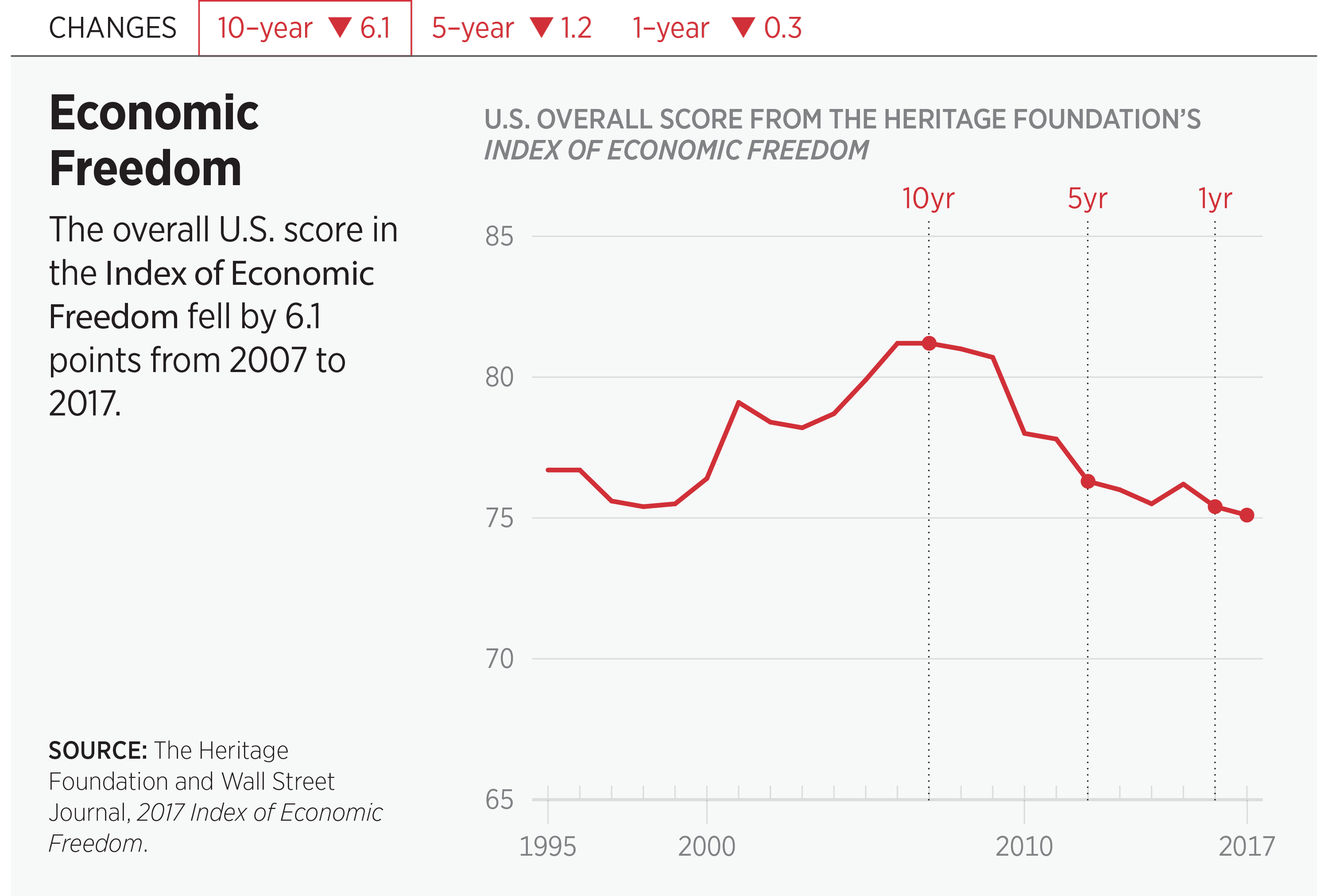The United States continues to decline in economic freedom as defined by The Heritage Foundation’s annual Index of Economic Freedom,1 even as the world as a whole improves ever so slightly. How can it be that the “leader of the free world” is no longer leading in freedom? Perhaps because policymakers have lost sight of how to encourage and incentivize the kind of economic activity that best contributes to both prosperity and human freedom.
The decline of small and medium-sized corporations (SMEs) tells the tale. SMEs are the engines of any economy. They account for 99.7 percent of our total number of companies.2 Since 1990, big business has eliminated 4 million jobs, but small businesses have added 8 million.3 More than 50 percent of the working population (120 million individuals) works in small businesses.4 SMEs are responsible for 46 percent of our GDP 5 and produce 16 times as many patents per employee as large patenting firms produce.6
Unfortunately, when government imposes hundreds of new regulations each year, SMEs disproportionately take the “hit.” Whereas large corporations can readily absorb the costs of new regulation (and indeed often welcome unnecessary regulations as barriers to competition), SMEs cannot. Thus, the prudence and justice of regulatory action must be measured against the obstacles to entry that it creates for young people or innovators just starting in the field.
Our policy of subsidizing the “too big to fail” economic giants has had a depressive effect on the SMEs that are the engines of prosperity. In the immediate aftermath of the 2008 economic crash, the SMEs’ death rate outnumbered their birth rate for the first time in our history.7 Nearly a decade later, their recovery is only marginal.8
To take a simpler example, the mere act of paying one’s taxes has become so complicated that “Mom-and-Pop” companies that used to do their own taxes now routinely hire CPAs rather than risk the costly fines that result from running afoul of multiple minor regulations. That is the sort of policy that eats away at margins, forces many enterprises to fold, and prevents countless others from entering the market in the first place.
If freedom consisted in being protected by regulation from anything that might go wrong, we might be on the right path, but if we measure our freedom by how easily the young, the poor, and the innovative can participate in and enter the economy, then the path we are on appears to be a dead end.
Andreas Widmer is Director of the Ciocca Center for Principled Entrepreneurship at the Catholic University of America’s Busch School of Business and Economics.
ENDNOTES:
1. “Economic freedom is the fundamental right of every human to control his or her own labor and property. In an economically free society, individuals are free to work, produce, consume, and invest in any way they please. In economically free societies, governments allow labor, capital, and goods to move freely, and refrain from coercion or constraint of liberty beyond the extent necessary to protect and maintain liberty itself.” See The Heritage Foundation, “About the Index,” 2017 Index of Economic Freedom, http://www.heritage.org/index/about (accessed April 17, 2017).
2. Small Business and Entrepreneurship Council, “Small Business Facts & Data,” http://sbecouncil.org/about-us/facts-and-data/ (accessed April 17, 2017).
3. U.S. Small Business Administration, “Small Business Trends,” https://www.sba.gov/managing-business/running-business/energy-efficiency/sustainable-business-practices/small-business-trends (accessed April 17, 2017).
4. Jason Nazar, “16 Surprising Statistics About Small Businesses,” Forbes, September 9, 2013, https://www.forbes.com/sites/jasonnazar/2013/09/09/16-surprising-statistics-about-small-businesses/#5cac46725ec8 (accessed April 17, 2017).
5. Kathryn Kobe, “Small Business GDP: Update 2002–2010,” prepared for U.S. Small Business Administration, Office of Advocacy, by Economic Consulting Services, LLC, January 2012, p. 1, https://www.sba.gov/sites/default/files/rs390tot_1.pdf (accessed April 28, 2017).
6. U.S. Small Business Administration, Office of Advocacy, “Frequently Asked Questions,” March 2014, p. 3, https://www.sba.gov/sites/default/files/FAQ_March_2014_0.pdf (accessed April 28, 2017).
7. United States Department of Labor, Bureau of Labor Statistics, “Business Employment Dynamics,” Chart 5, “Quarterly Establishment Births and Deaths, 1993–2015,” April 28, 2016, https://www.bls.gov/bdm/entrepreneurship/entrepreneurship.htm (accessed April 28, 2017).
8. Ibid.

